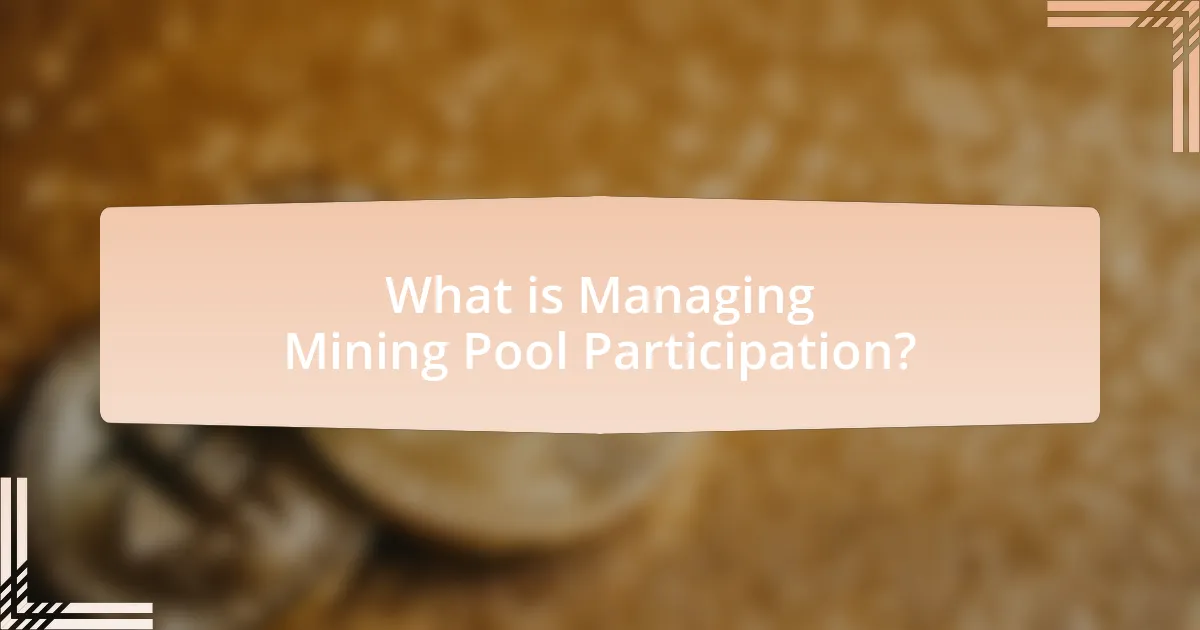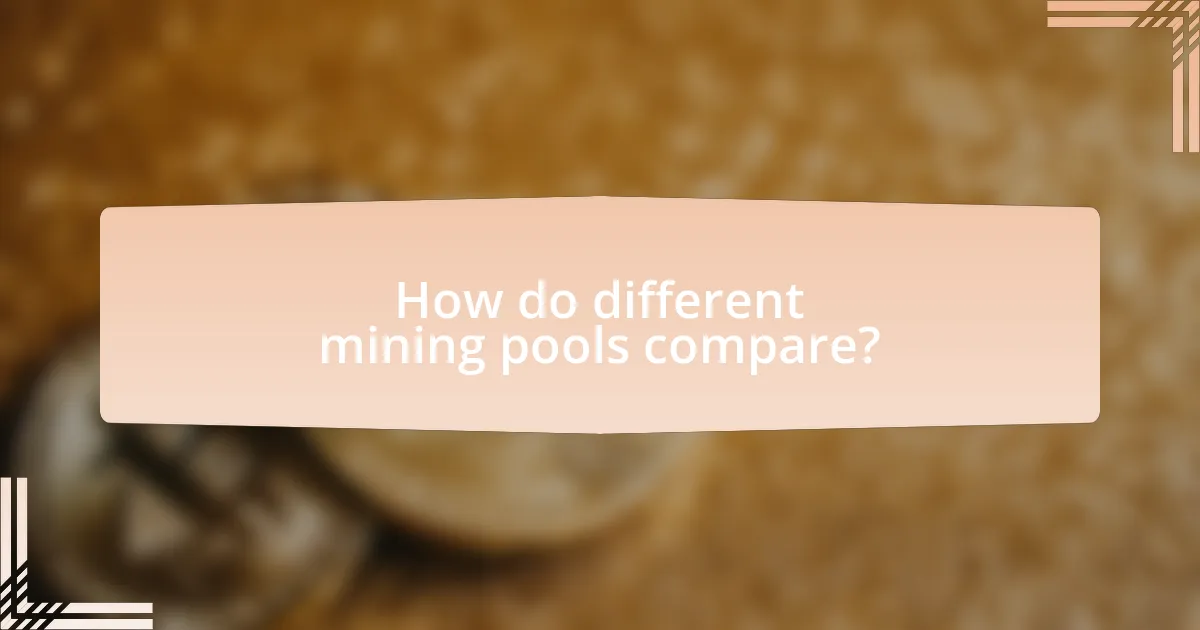Managing mining pool participation involves overseeing and optimizing a miner’s involvement in a collective group that combines computational resources to enhance the chances of successfully mining cryptocurrency. The article explores how mining pools operate, their key components, and the advantages and disadvantages of participation. It discusses factors to consider when selecting a mining pool, including fees, payout structures, and pool size, while also addressing potential risks such as centralization and reliance on pool operators. Additionally, the article highlights best practices for maximizing earnings and mitigating challenges faced by miners in these collaborative environments.

What is Managing Mining Pool Participation?
Managing mining pool participation refers to the process of overseeing and optimizing a miner’s involvement in a collective group that combines computational resources to increase the chances of successfully mining cryptocurrency. This management includes selecting the right mining pool based on factors such as fees, payout structures, and the pool’s overall performance. Effective management can lead to higher rewards and more efficient use of resources, as miners share their computational power to solve complex mathematical problems collaboratively.
How does mining pool participation work?
Mining pool participation allows individual miners to combine their computational resources to increase the chances of successfully mining cryptocurrency blocks. In this collaborative environment, miners contribute their hashing power to the pool, and when the pool successfully mines a block, the rewards are distributed among participants based on their contributed power. This method enhances the likelihood of earning rewards compared to solo mining, where the chances of finding a block are significantly lower due to increased network difficulty. According to a study by the Cambridge Centre for Alternative Finance, mining pools account for over 70% of the total Bitcoin network hash rate, demonstrating their prevalence and effectiveness in the mining ecosystem.
What are the key components of a mining pool?
The key components of a mining pool include a pool operator, miners, a payout system, and a communication protocol. The pool operator manages the infrastructure and coordinates the mining activities, while miners contribute their computational power to solve blocks collectively. The payout system determines how rewards are distributed among participants, often based on their contributed hash rate. Lastly, the communication protocol facilitates the exchange of information between miners and the pool, ensuring efficient operation and coordination. These components work together to enhance mining efficiency and increase the likelihood of earning rewards.
How do miners join and leave mining pools?
Miners join mining pools by selecting a pool, creating an account, and configuring their mining software to connect to the pool’s server. This process typically involves entering the pool’s URL and their account credentials into the mining software. Miners leave mining pools by disconnecting their mining software from the pool’s server and, if necessary, deleting their account on the pool’s website. This flexibility allows miners to switch pools based on factors like fees, payout structures, and overall performance.
What are the advantages of participating in mining pools?
Participating in mining pools offers several advantages, primarily increased chances of earning rewards. By joining a mining pool, individual miners combine their computational power, which enhances the likelihood of successfully mining blocks and receiving payouts. This collective effort reduces the variance in income, as miners receive smaller, more frequent payouts instead of waiting for a long time to mine a block independently. Additionally, mining pools often provide access to better resources and tools, such as advanced mining software and technical support, which can improve overall mining efficiency. According to a study by the Cambridge Centre for Alternative Finance, mining pools account for over 70% of the total Bitcoin network hash rate, demonstrating their significant role in the mining ecosystem and the benefits they provide to participants.
How does pooling resources increase mining efficiency?
Pooling resources increases mining efficiency by allowing multiple miners to combine their computational power, which enhances the likelihood of successfully solving complex cryptographic puzzles. This collaboration leads to more consistent and predictable rewards, as the combined hash rate of the pool increases the chances of earning block rewards compared to individual mining efforts. For instance, a mining pool with a hash rate of 1 TH/s can solve blocks significantly faster than a single miner with 1 GH/s, resulting in more frequent payouts for all participants. This efficiency is supported by the fact that mining pools can reduce variance in earnings, providing miners with steadier income streams and optimizing resource utilization.
What financial benefits do miners gain from mining pools?
Miners gain several financial benefits from participating in mining pools, primarily through increased chances of earning consistent rewards. By pooling their computational resources, miners can collectively solve blocks more frequently than they could individually, leading to more regular payouts. For instance, mining pools distribute rewards based on the contributed hashing power, which means even miners with lower individual power can receive a share of the rewards proportional to their contribution. This system mitigates the income volatility associated with solo mining, where a miner may go long periods without earning anything. Additionally, mining pools often have lower operational costs and provide access to better infrastructure, further enhancing profitability for individual miners.
What are the potential drawbacks of mining pool participation?
Mining pool participation can lead to several potential drawbacks, including reduced individual rewards, reliance on the pool operator, and increased centralization of mining power. When miners join a pool, they share their computational power, which means that the rewards are distributed among all members based on their contribution, often resulting in smaller payouts compared to solo mining. Additionally, miners depend on the pool operator for the distribution of rewards and the management of the pool, which can introduce risks such as mismanagement or dishonest practices. Furthermore, as more miners join pools, the concentration of mining power can lead to centralization, undermining the decentralized nature of blockchain networks and potentially making them more vulnerable to attacks or manipulation.
How does pool centralization affect individual miners?
Pool centralization negatively impacts individual miners by reducing their potential earnings and increasing their dependency on larger mining pools. When mining pools become centralized, a few dominant entities control the majority of the network’s hashing power, leading to unequal distribution of rewards. This centralization can result in smaller miners receiving lower payouts due to the proportional distribution model, where rewards are shared based on the amount of hashing power contributed. Additionally, centralized pools may impose higher fees, further diminishing individual miners’ profits. According to a study by the Cambridge Centre for Alternative Finance, as of 2021, the top four mining pools controlled over 60% of the Bitcoin network’s hash rate, illustrating the extent of centralization and its detrimental effects on individual miners’ financial outcomes.
What risks are associated with relying on mining pools?
Relying on mining pools presents several risks, including centralization, reduced rewards, and potential security vulnerabilities. Centralization occurs when a few mining pools dominate the network, which can lead to a single point of failure and increased susceptibility to attacks, such as a 51% attack. Reduced rewards happen because miners share their earnings with the pool, resulting in lower individual payouts compared to solo mining. Additionally, security vulnerabilities arise from the pooling of resources, as hackers may target large pools to exploit their collective power or steal funds. These risks highlight the importance of careful consideration when participating in mining pools.

How do different mining pools compare?
Different mining pools vary significantly in terms of fees, payout structures, and overall performance. For instance, some pools charge lower fees but may have less frequent payouts, while others might have higher fees but offer more consistent rewards. A study by BitMEX Research in 2020 highlighted that larger pools tend to have higher hash rates, which can lead to more stable payouts, but they also face centralization risks. Additionally, smaller pools may provide better incentives for individual miners through unique payout methods like Pay Per Share (PPS) or Pay Per Last N Shares (PPLNS), which can affect overall profitability. Thus, miners must evaluate these factors to choose a pool that aligns with their goals and risk tolerance.
What factors should be considered when choosing a mining pool?
When choosing a mining pool, factors such as pool fees, payout structure, pool size, and reputation should be considered. Pool fees directly impact profitability; lower fees increase earnings. The payout structure, whether it is Pay Per Share (PPS) or Pay Per Last N Shares (PPLNS), affects how and when miners receive their rewards. Pool size influences the likelihood of finding blocks; larger pools may provide more consistent payouts but can dilute individual earnings. Reputation is crucial, as established pools with positive feedback are less likely to engage in dishonest practices. These factors collectively determine the overall effectiveness and reliability of a mining pool for miners.
How do payout structures vary among mining pools?
Payout structures among mining pools vary primarily in their distribution methods, which can include Pay-Per-Share (PPS), Pay-Per-Last-N-Shares (PPLNS), and proportional payout systems. In a Pay-Per-Share system, miners receive a fixed amount for each share they submit, providing consistent payouts regardless of the pool’s success in finding blocks. Conversely, the PPLNS method rewards miners based on the number of shares they contribute over a specific period, which can lead to higher payouts during successful mining streaks but less predictability. Proportional systems distribute rewards based on the number of shares submitted relative to the total shares submitted by all miners when a block is found, resulting in variable payouts depending on the pool’s performance. These differences impact miners’ earnings and risk exposure, influencing their choice of mining pool.
What are the reputations of popular mining pools?
Popular mining pools such as F2Pool, Poolin, and Slush Pool have established strong reputations within the cryptocurrency mining community. F2Pool is recognized for its reliability and extensive support for various cryptocurrencies, boasting a significant market share of around 15% in Bitcoin mining as of 2023. Poolin is noted for its user-friendly interface and diverse mining options, attracting a large user base due to its competitive fees and efficient payout system. Slush Pool, one of the oldest mining pools, is respected for its transparency and security features, contributing to its reputation as a trustworthy choice among miners. These pools have built their reputations through consistent performance, user satisfaction, and adherence to security protocols, making them prominent players in the mining landscape.
How does the choice of mining pool impact profitability?
The choice of mining pool significantly impacts profitability by influencing the distribution of rewards and the likelihood of earning consistent payouts. Different mining pools have varying fee structures, payout methods, and block discovery rates, which can directly affect miners’ earnings. For instance, a pool with a higher fee may reduce overall profits, while a pool that pays out more frequently can provide steadier income. According to a study by the University of Cambridge, miners in pools with lower fees and higher block discovery rates tend to achieve better profitability over time. Thus, selecting the right mining pool is crucial for maximizing returns in cryptocurrency mining.
What role do fees play in mining pool profitability?
Fees significantly impact mining pool profitability by directly reducing the earnings of miners participating in the pool. Mining pools typically charge fees ranging from 1% to 3% of the rewards earned, which means that higher fees can diminish the overall profit for miners. For instance, if a mining pool charges a 2% fee and a miner earns 1 Bitcoin, the miner would receive only 0.98 Bitcoin after the fee is deducted. This reduction in earnings can influence a miner’s decision to join a particular pool, as lower fees can lead to higher net profits. Therefore, the structure and level of fees are crucial factors in determining the attractiveness and profitability of mining pools for individual miners.
How does pool size influence earnings for miners?
Pool size significantly influences earnings for miners by determining the frequency and size of payouts. Larger mining pools increase the likelihood of solving blocks more frequently, leading to more consistent and predictable earnings for participants. For instance, a pool with thousands of miners can solve blocks more often than a smaller pool, distributing rewards more regularly among its members. This is evidenced by the fact that miners in larger pools often receive smaller, but more frequent payouts, while those in smaller pools may experience larger payouts but less frequency, resulting in higher variance in earnings.

What best practices should miners follow when participating in pools?
Miners should prioritize transparency, security, and effective communication when participating in pools. Transparency involves selecting pools that provide clear information about fees, payout structures, and mining strategies, which helps miners understand their potential earnings and costs. Security is crucial; miners should choose pools with robust security measures, such as two-factor authentication and regular audits, to protect their assets from potential hacks. Effective communication with pool operators and other miners fosters a collaborative environment, allowing for the sharing of strategies and updates on pool performance. Following these best practices enhances miners’ overall experience and profitability in mining pools.
How can miners maximize their earnings in a mining pool?
Miners can maximize their earnings in a mining pool by selecting a pool with low fees, optimizing their hardware for efficiency, and participating in pools that offer favorable payout structures. Choosing a mining pool with fees typically ranging from 1% to 3% can significantly increase net earnings, as higher fees reduce overall profits. Additionally, optimizing hardware settings, such as clock speeds and power consumption, can enhance mining performance, leading to increased rewards. Furthermore, miners should consider pools that utilize payout methods like Pay Per Share (PPS) or Pay Per Last N Shares (PPLNS), which can provide more consistent and higher payouts based on individual contributions. These strategies are supported by the fact that miners who actively manage their pool participation and hardware settings often report higher profitability compared to those who do not.
What strategies can be employed to select the best mining pool?
To select the best mining pool, evaluate factors such as pool fees, payout structure, pool size, and reputation. Pool fees typically range from 1% to 3%, and lower fees can increase profitability. The payout structure, whether it’s Pay Per Share (PPS) or Pay Per Last N Shares (PPLNS), affects how and when miners receive rewards. A larger pool may offer more consistent payouts due to higher collective hashing power, but smaller pools can provide higher rewards per share. Additionally, researching the pool’s reputation through user reviews and historical performance data can help ensure reliability and trustworthiness.
How can miners mitigate risks associated with mining pools?
Miners can mitigate risks associated with mining pools by diversifying their participation across multiple pools. This strategy reduces dependency on a single pool, thereby minimizing the impact of potential pool failures or changes in payout structures. Additionally, miners should conduct thorough research on the pools they join, focusing on their reputation, payout methods, and fee structures. For instance, a study by the Cambridge Centre for Alternative Finance highlights that miners who spread their resources across various pools can achieve more stable earnings and reduce volatility in their income. By implementing these practices, miners can enhance their resilience against the inherent risks of mining pool participation.
What common challenges do miners face in mining pools?
Miners in mining pools commonly face challenges such as unequal distribution of rewards, reliance on pool operators, and potential centralization of mining power. Unequal distribution occurs because miners contribute varying amounts of computational power, leading to discrepancies in reward sharing. Reliance on pool operators can create vulnerabilities, as miners depend on them for accurate payouts and operational integrity. Additionally, centralization of mining power can undermine the decentralized nature of blockchain networks, as larger pools may dominate the mining process, reducing competition and increasing the risk of collusion. These challenges highlight the complexities miners encounter when participating in mining pools.
How can miners address issues of pool downtime?
Miners can address issues of pool downtime by diversifying their mining activities across multiple pools. This strategy ensures that if one pool experiences downtime, miners can continue to earn rewards from other active pools. Research indicates that miners who participate in multiple pools can mitigate the financial impact of downtime, as they are not solely reliant on a single source for their mining rewards. Additionally, miners can monitor pool performance metrics and switch to more reliable pools based on historical uptime data, further enhancing their operational efficiency.
What should miners do if they experience payout discrepancies?
Miners should immediately report payout discrepancies to their mining pool’s support team. This action allows the pool operators to investigate the issue and rectify any errors in the payout system. Miners should provide detailed information about the discrepancy, including timestamps, transaction IDs, and any relevant screenshots, to facilitate a thorough review. Prompt reporting is crucial, as many mining pools have specific policies regarding payout adjustments and timelines for addressing such issues.